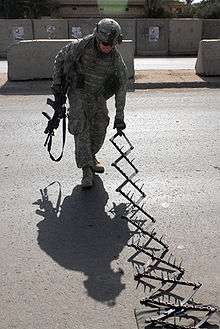Spike strip
A spike strip (spike belt, traffic spikes, tire shredders, one-way traffic treadles, stingers, stop sticks, a stinger in police slang, and formally known as a tire deflation device) is a device or incident weapon used to impede or stop the movement of wheeled vehicles by puncturing their tires. Generally, the strip is composed of a collection of 35-to-75-millimetre-long (1 1⁄2 to 3 in) metal barbs, teeth or spikes pointing upward. The spikes are designed to puncture and flatten tires when a vehicle is driven over them; they may be detachable, with new spikes fitted to the strip after use. The spikes may be hollow or solid; hollow ones are designed to detach and become embedded in the tires, allowing air to escape at a steady rate to reduce the risk of the driver losing control and crashing. One type was co-invented by Donald Kilgrow, a retired Utah Highway Patrol trooper, along with a design engineer.[1] They are historically a development of the caltrop, anti-cavalry and anti-personnel versions being used as early as 331 BC by Darius III against Alexander the Great at the Battle of Gaugamela in Persia.
In the United States, five officers were killed deploying spike strips in 2011 alone. Dallas, Texas police are among those banned from using them, in response to the hazards.[2]
Remotely deployable spike strips have been invented to reduce the danger to police officers deploying them.[3] Spike strips are also built into some parking barriers to control traffic flow.
Private possession of spike strips was banned in New South Wales, Australia in 2003 after a strip cheaply constructed from a steel pipe studded with nails was used against a police vehicle. John Watkins, a member of New South Wales Legislative Assembly, stated they would be added to the New South Wales prohibited weapons list.[4]
Following the rise in terrorist vehicle attacks whereby a vehicle is driven at speed into pedestrians, a net with steel spikes that can be deployed by two people in less than a minute, reported able to stop a vehicle of up to 17 tonnes, was developed for preventive use at public events in the UK, with the name "Talon". It has steel spikes to puncture tires, and becomes entangled around the front wheels, halting the vehicle. It is designed to reduce risk to crowds by making the vehicle skid in a straight line without veering unpredictably. It was first deployed to protect a parade on 11 September 2017.[5]
See also
- High-speed chase
References
| Wikimedia Commons has media related to Spike strips. |
- Beard, Jonathan (24 August 1991). "Technology: Spikes end chases with a hiss not a bang". New scientist (1783). Retrieved 27 September 2009.
- "Dallas police ban use of spike strips that can halt fleeing vehicles". Dallas Morning News. June 8, 2012.
- "DynaSpike Remote Control Spike System". dynasystems2.
- "Ban on home-made road spikes after car chase". The Sydney Morning Herald. December 10, 2003.
- "Steel spiked net to tackle London vehicle terror attacks". BBC News. 11 September 2017. Retrieved 11 September 2017.
